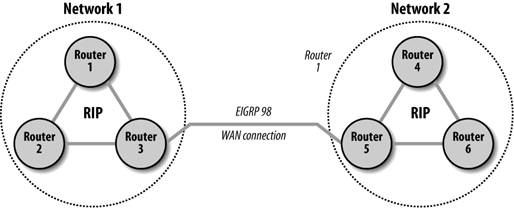Autonomous System (AS) Numbers
An autonomous system is a collection of routers that is under the control of one organization (for example, one corporation's network). Within this organization, the routers share routing information only among themselves. At a macroscopic level, autonomous systems can be viewed as single entities. An exterior routing protocol, such as BGP, needs to worry only about autonomous systems and can ignore any structure within the autonomous system.
Properly speaking, AS numbers are assigned by ARIN (the American Registry for Internet Numbers) and are used only by BGP. A limited number are available, so they are assigned only to organizations that really need them.[*]
[*] For more information on AS number assignment, see http://www.arin.net/regserv/asnguide.htm.
However, IGRP and EIGRP use a unique number to define boundaries between groups of routers that share information. This number can be considered a "locally significant AS" or "local-AS," which means the number is important only to your network. You can configure a router to run multiple routing processes using the same protocol, but they won't share routing information because their local-AS numbers differ.
Consider the following configuration:
router igrp 100 network 192.168.1.0 router igrp 200 network 10.0.0.0
Here, we have two routing processes running IGRP. However, the two processes don't share information because they have different local-AS numbers (100 and 200). Using local-AS numbers in this way allows you to divide a network into separate domains. A local-AS number is more properly called a process number to distinguish it from a true AS number. But you'll see both terms used frequently, and I'll use both in this book.
OSPF uses a unique number called a process ID to identify the routing process on the router. These numbers do not partition the network the way a local-AS number does.
RIP does not use AS numbers because it shares routes with any neighboring RIP router that will listen. Therefore, the routing domains are defined by router boundaries. These boundaries can be border routers that are not running RIP, access lists that prohibit the RIP packets from traveling past a certain router, or any router more than 15 hops away, which RIP considers unreachable.
In Figure 8-1, Routers 1, 2, and 3 in Network 1 are running the RIP protocol. Similarly, in Network 2, Routers 4, 5, and 6 share routing information via RIP. Each network distributes routing information to all its routers because RIP communicates with all adjacent routers that are also running RIP. However, RIP routes are not distributed from one network into the other because we are not running RIP on the link between Router 3 and Router 5. Instead, we run EIGRP across the WAN connection with a local-AS number of 98. Since both Routers 3 and 5 use the same local-AS number, they can exchange routing information. However, by default, the EIGRP processes don't know anything about the RIP routes. To make this information available via EIGRP, we need to add route distribution, which is covered later in this chapter.
Figure 8-1. The distribution of routing information

|
Getting Started
- Getting Started
- IOS User Modes
- Command-Line Completion
- Get to Know the Question Mark
- Command-Line Editing Keys
- Pausing Output
- show Commands
IOS Images and Configuration Files
- IOS Images and Configuration Files
- IOS Image Filenames
- The New Cisco IOS Packaging Model
- Loading Image Files Through the Network
- Using the IOS Filesystem for Images
- The Routers Configuration
- Loading Configuration Files
Basic Router Configuration
- Basic Router Configuration
- Setting the Router Name
- Setting the System Prompt
- Configuration Comments
- The Enable Password
- Mapping Hostnames to IP Addresses
- Setting the Routers Time
- Enabling SNMP
- Cisco Discovery Protocol
- System Banners
Line Commands
- Line Commands
- The line Command
- The Console Port
- Virtual Terminals (VTYs)
- Asynchronous Ports (TTYs)
- The Auxiliary (AUX) Port
- show line
- Reverse Telnet
- Common Configuration Items
Interface Commands
- Interface Commands
- Naming and Numbering Interfaces
- Basic Interface Configuration Commands
- The Loopback Interface
- The Null Interface
- Ethernet, Fast Ethernet, and Gigabit Ethernet Interfaces
- Token Ring Interfaces
- ISDN Interfaces
- Serial Interfaces
- Asynchronous Interfaces
- Interface show Commands
Networking Technologies
Access Lists
IP Routing Topics
- IP Routing Topics
- Autonomous System (AS) Numbers
- Interior and Exterior Gateway Protocols
- Distance-Vector and Link-State Routing Protocols
- Static Routes
- Split Horizon
- Passive Interfaces
- Fast Switching and Process Switching
Interior Routing Protocols
Border Gateway Protocol
- Border Gateway Protocol
- Introduction to BGP
- A Simple BGP Configuration
- Route Filtering
- An Advanced BGP Configuration
- Neighbor Authentication
- Peer Groups
- Route Reflectors
- BGP Confederacies
- BGP TTL Security
Quality of Service
- Quality of Service
- Marking
- Older Queuing Methods
- Modern IOS QoS Tools
- Congestion Avoidance
- Traffic Policing
- Traffic Shaping
- AutoQoS
- QoS Device Manager
Dial-on-Demand Routing
- Dial-on-Demand Routing
- Configuring a Simple DDR Connection
- Sample Legacy DDR Configurations
- Dialer Interfaces (Dialer Profiles)
- Multilink PPP
- Snapshot DDR
Specialized Networking Topics
- Specialized Networking Topics
- Bridging
- Hot Standby Routing Protocol (HSRP)
- Network Address Translation (NAT)
- Tunnels
- Encrypted Tunnels
- Multicast Routing
- Multiprotocol Label Switching (MPLS)
Switches and VLANs
- Switches and VLANs
- Switch Terminology
- IOS on Switches
- Basic Switch Configuration
- Trunking
- Switch Monitor Port for IDS or Sniffers
- Troubleshooting Switches
Router Security
- Router Security
- Securing Enable Mode Access
- Routine Security Measures
- Restricting Access to Your Router
Troubleshooting and Logging
Quick Reference
Appendix A Network Basics
Index
EAN: 2147483647
Pages: 1031

